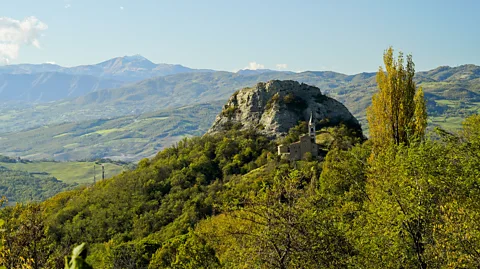Research on abandoned chestnut orchards has shown that when left alone, chestnut trees are crowded out by other species. In wild forests, “Castanea reaches a maximum age of about 200 years, then it dies,” Krebs says. “But here in Ticino, where chestnuts have been cultivated, they can reach up to almost 1,000 years, because of their symbiosis with humans.”
 Getty Images
Getty ImagesBy the end of the Roman era, the sweet chestnut had become the dominant tree species in Ticino, displacing a previous forest-scape of alders and other trees, the pollen record shows: “This was done by humans. It was a complete reorganisation of the vegetal landscape,” Krebs explains.
In fact, pollen evidence from a site in Ticino at some 800m (2,625ft) above sea level shows that during the Roman period there was a huge increase in Castanea pollen, as well as cereal and walnut-tree pollen, suggesting an orchard was kept there, Krebs says. (Read more about the traces left by passing Romans and other ancient civilisations in the Alps.)
By the Middle Ages, long after the Romans were gone, many historical texts document the dominance of sweet chestnut production and the importance of foods such as chestnut flour in Ticino, says Krebs. “In our valleys, chestnuts were the most important pillar of subsistence during the Middle Ages.”
People in Ticino continued to look after the trees, planting them, coppicing them, pruning them and keeping out the competition, over centuries, Krebs says: “That’s the nature of this symbiosis: humans get the fruit [and wood] of the chestnut tree – and the chestnut gets longevity”, as well as the opportunity to hugely extend its natural area of distribution, he explains.
A similar transfer of chestnut-related knowledge to locals may have happened elsewhere in the Roman Empire, he suggests – and possibly left linguistic traces. As a separate study shows, across Europe, the word for “chestnut” is similar to the Latin “castanea” in many languages.
Today, Europe’s sweet chestnut trees are facing threats including disease, climate change and the abandonment of traditional orchards as part of the decline in rural life. But chestnut trails and chestnut festivals in Ticino and other parts of the southern Alps still celebrate the history of sweet chestnuts as a past staple food – reminding us of the long legacy of both Roman and local ideas and skills in tree-care.